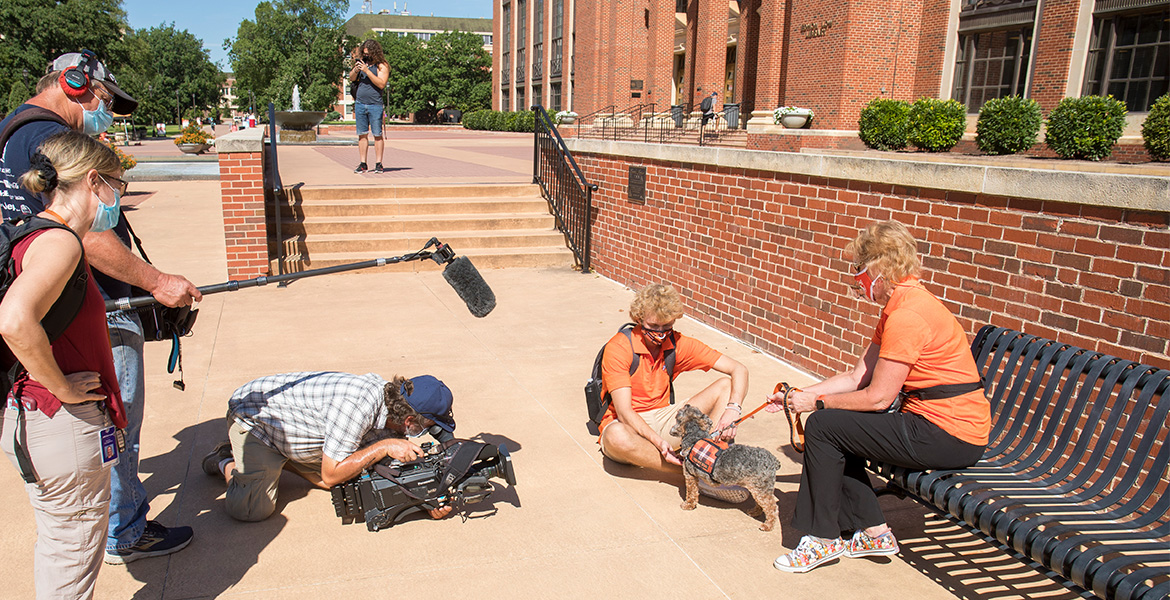Developing an effective Business to Government (B2G) marketing strategy to reach decision-makers in the public sector requires a handful of marketing tactics, perhaps the most impactful of which is a well-founded public relations program. However, before diving headfirst into a multi-faceted digital marketing campaign, it is critical to recognize that government agencies have many different challenges than private-sector organizations, and therefore doing business with these agencies requires a much more tailored approach.
Many government agencies, especially at the state and local level, work in silos — meaning that it is often difficult for these agencies to get the technology, resources and expertise they need to efficiently serve their citizens. One recent survey found that more than 80% of U.S. government officials feel their agency is technologically behind where it needs to be in order to handle the new challenges it faces.
In order to effectively engage federal, state, and/or local government agencies, businesses must first understand the perspectives and challenges those entities face and where to best reach them. Once you’ve gotten a grasp on the barriers and challenges agencies face in working with you, you can begin to build out a content strategy that addresses those challenges and helps you get a foot in the door. Luckily, experienced PR agencies are well-versed in how to help cultivate messaging that will resonate with both government-oriented media outlets as well as the decision-makers themselves.

Target content at agency decision-makers
In order to speak the language of government decision-makers, contractors need to develop content that speaks directly to agency decision-maker pain-points. Government agency contractors must also understand that government decision-makers are driven by different motivators than in an enterprise environment.
Everything does not necessarily revolve around profits for them, therefore content must speak to decision-makers’ primary pain points. Messages that pivot away from the bottom-line, and refocus on unique challenges of the targeted government agencies will earn attention. Timing is also critical — organizations must hit decision-makers at the right time in the procurement process with content and knowledge that stands out in what is a very commoditized market where government-contractor and tech company messaging all seem to blur together.

Establish expertise in your market category
Understanding your organization’s existing and aspirational market footprint is the first step in carving out a niche that you can own as a thought leader. For example, there are countless cybersecurity vendors in the public sector, all of which sell a variety of security solutions that promise relatively similar results e.g. “visibility, detection, the response against evolving threats.” To gain real traction as a thought leader in the public sector, you must drill down into your specific two to three areas of expertise.
Once you’ve laser-focused on the arena in which you’re planning to own, a PR team of consultants can help you build out an editorial calendar of topics and discussions you want to participate in to align your content with quarterly and annual sales goals. This process of self-vetting and prioritizing will result in an organized and unified message about your company and its areas of knowledge when featured in editorial and published content.

Identify and prioritize your future-oriented solutions
Many organizations in the B2G marketplace make the mistake of getting stuck in the ruts in which they have always operated. They may have one or two solutions that sell well to their target audiences, so they become complacent in innovating new product lines or messaging.
For example, in the 1960s and 70s tech-giant, IBM’s top-grossing product was a typewriter. It may have seemed safe at the time to streamline their operations and prioritize their top-grossing product as opposed to developing and pitching new products and technologies to their customers. With the benefit of time we now realize that typewriters were soon made obsolete by keyboard computers, meaning that if IBM would have centered its business model around typewriters, they would not be the tech giant with a global footprint they have today.
All this goes to say, it is imperative that businesses selling to government agencies consider that their top-grossing products may soon be eclipsed by newer, faster, stronger, and more advanced solutions. Keeping an eye and ear toward future government agency needs will help organizations stay on the cutting edge of tech demands in government. Cultivating relevant, thought-provoking content that stands out to public sector decision-makers is one of the primary in-roads to conducting business with the government. If you want to learn more about how we have driven successful B2G content programs through PR and digital campaigns, get in touch with Bluetext.
Bluetext’s public relations client SAS has long been a trusted partner of colleges and universities around the world, leveraging their advanced analytics capabilities to provide safe, effective learning environments for students.
This year, the task of providing a safe and effective learning environment is much more challenging as an abundance of COVID-19 makes gathering in tight quarters like dorms, classrooms, and campuses without spreading the virus next to impossible. As a result, many universities have taken detailed measures to plan for student safety in the event of new outbreaks upon their return to campus.
One of these is Oklahoma State University (OSU), where administrators are leveraging SAS technology combined with unique campus data to track the spread of COVID-19 using contact tracing and data analytics.

To be ready for the return of students, faculty, and staff, OSU has integrated different data sources to create inferred links between people, places, and times. OSU connected institutional data such as time and location-based information from its extensive campus Wi-Fi network with over 5,000 access points. This data is then combined with other location-based information such as campus store purchases, card swipes, class schedules and more, which can be linked directly to individual students and provide a more complete picture of anyone who has been in contact with a confirmed case of COVID and anyone who has been in the same location for more than 15 minutes.
These OSU data models generate alerts if the data indicates quarantines or isolations are broken, or if a super-spreader is suspected, and provides general alerts for faculty and students. The data will also be used to help identify areas in need of increased cleaning, social distance monitoring, and other education efforts.
The Today Show recently visited Oklahoma State University and followed a freshman student through a day in his campus life amid COVID, illustrating how the university is leveraging its campus data to track where students have been in the event that new cases of COVID are identified.
Watch this segment of The Today Show here.
This Sunday, the Kansas City Chiefs will square off against the San Francisco 49ers in Super Bowl LIV; anticipated to be one of the most entertaining sporting events of the year brought to you by gunslinging quarterbacks Patrick Mahomes and Jimmy Garoppolo.
Thanks to two electrifying football teams and the unofficial holiday that comes with Super Bowl Sunday, a projected 100+ million viewers in the U.S. will tune into FOX at the same time, creating an unparalleled opportunity for marketing pros to cultivate a memorable brand association with more than a quarter of the U.S. population.
But these opportunities do not come cheap
Outside of the cost of producing the commercials, (which anyone in marketing can tell you isn’t cheap) you have to pay egregious dollar figures just to place it on the primetime Super Bowl stage. FOX sold out of its Super Bowl ad slots in late November, which reportedly sold for between $5 million and $5.6 million.
$5.6 million!
Let that number sink in. $5.6 million could buy you a five-bedroom house with a view of the Golden Gate Bridge in downtown San Francisco. Or 10 five-bedroom houses in the Kansas City-area. Suffice to say, there’s a lot you could do with that money.
From a marketing standpoint, if your brand is considering purchasing a primetime 30-second Super Bowl ad, or you’re simply wondering how you could make a splash during the event without blowing your entire annual budget, consider these marketing alternatives that you could buy for the same price:
1. 20 years of a PR retainer at 20K per month
While it probably does not make sense to stretch one year’s marketing budget over the next two decades, this illustrates how far your marketing dollar could go over time with a PR budget as opposed to a single, 30-second Super Bowl ad. A monthly PR retainer could produce the ability for your brand to demonstrate expertise to more targeted audiences than the general public watching the Super Bowl at a fraction of the cost. This is typically executed with media relations and strategic placements of messaging within publications of interest to the brand’s most important audiences. Spending your marketing dollars in this way would create a steady burn of messaging over a long period of time as opposed to one, 30-second firework explosion of your brand that a large portion of the Super Bowl audience could miss.
2. Multiple omnichannel digital campaigns
In order for any Super Bowl campaign to be successful, it must eventually migrate to the digital realm in one way or another. Outside of the $5.6 million it will cost to run the ad in the spotlight, brands also have to shell out at least another $1 million to market the ad via social media. So why not go straight to digital with your campaign?
Newcastle Brown Ale was among the first to attempt this digital-first Super Bowl strategy in 2014 with a satirical YouTube commercial featuring Anna Kendrick about the Super Bowl commercial they almost made but didn’t have the money. By posting the video directly to YouTube and spending all of their resources marketing the commercial online, they found a witty way to poke fun at the nature of Super Bowl commercials by making one while also saving A LOT of money in the process. Digital campaigns can be an extremely effective (not to mention more targeted) way of maximizing your exposure to your key audiences. Ultimately the third-party validation that will come from individuals sharing your content will be the mark of a successful campaign, so digital-first strategies could be the next iteration of Super Bowl commercials.
3. Yearly platinum sponsorships in ten of your audience’s favorite publications
If your brand is targeting audiences that congregate around specific media outlets, paid partnerships with those media outlets can be a great way to enhance your exposure to the people who matter most. Sponsorship packages at media publications vary based on their target audience, the type of content they typically publish, and what you’ll get for your spend. But with big dollar figures in the hundreds of thousands, you could expect millions of unique viewers, digital ad space, thought leadership content, lead-gen, sponsored webinars, and more!
As Americans and football fans around the world tune in to the game on February 2, household brands will be vying for your loyalty and lesser-known companies will be introducing themselves to the world on the hottest advertising real estate money can buy. However, you can also expect to see many organizations turning to alternative marketing to make their splash during the game.
The real winners of this international media event will not be limited to just the Chiefs or the 49ers, but also to the organizations who strategically employ ALL of the marketing tactics available to them.
Securing the attention of journalists and editors in the modern media landscape is becoming increasingly difficult as journalists are busy with tighter deadlines, lower budgets, and more news to cover than ever before. According to the US Department of Labor, PR professionals now outnumber journalists by a ratio of more than 6-to-1, after employment dropped in newsrooms by 23% between 2008 and 2017.
Now, with more PR pitches flooding media inboxes, it’s critical to operate in a way that isn’t going to get your (or your entire agency’s) email blacklisted. Still, the value of a public relations practitioner according to PRSA is advocacy, i.e. “providing a voice in the marketplace of ideas, facts, and viewpoints of our clients.”
An effective public relations program establishes legitimacy with journalists by contributing thoughtful, accurate and newsworthy information to help the media better inform public debate. Above all, we’re here for our clients to help promote their ideas and insert them into the conversations which they belong. But as PR pros, we also must understand and have a deep appreciation for the fact that our ultimate goals depend on the efforts of the hardworking media personnel we interact with on a daily basis.
Here are four tips for how effective PR professionals improve their relationships with the media:
Think before you pitch. The most common piece of feedback journalists give to PR professionals is that their pitch isn’t a fit for their reporting. Often times, PR teams legitimize pitching an announcement to a large audience for “general awareness” without doing substantial research on the people who will receive the pitch. More often than not, the announcement will not be relevant to a large percentage of that list. Even if the news is relevant, the reporter may have just written a story about it and will not likely be interested in a follow-up.
When a journalist receives a pitch that is out of their editorial scope, it’s important to recognize that this lack of interest can have more permanent effects than just an ignored email. If this “spray and pray” approach comes through on a repetitive basis, then the communications agency can develop a reputation for thoughtlessly spamming news outlets with client announcements, and run the risk of being blacklisted from their reporters. Other small fixes like typos, using a journalist’s common name, and pitching in the context of other recent pitches you’ve sent that outlet can be crucial in gaining attention and having a real conversation with the reporter.
The best way to avoid these types of problems is to simply take time to research media contacts and the types of stories they want to tell before sending news their way; it saves time for all involved.
Be authentic. The cardinal rule of PR is “legitimacy.” Looking legit in the eyes of the public starts by being authentic and telling the best true story you have the ability to tell. Especially when talking to reporters and stakeholders who are regularly contacted about a client, it’s important to use language that is both professional and sounds like something that would be said in a normal conversation.
Too often, pitches and public statements get bogged down by bureaucratic language and technical descriptions to the point that they lose their effectiveness on the audience because no one can understand the take-home point. It’s natural to want to use jargon, but it’s the job of a PR pro to usher a client’s message into the pool of public discourse and help people understand the larger story behind a given announcement.
Provide true news value. Anyone can write a press release about how great their company is, but getting a news reporter or editor to do so is a different story entirely. News outlets have editorial teams to filter content for audiences and help them distinguish between a self-serving company announcement and news that can help inform public discourse. As a journalist once told me, “we wouldn’t run a story from McDonald’s about the benefits of eating cheeseburgers.”
Considerations like these must be top of mind for any PR professional’s strategy when interacting with media. Distinguishing between the news that is valuable for a company and the news that is valuable to reporters and editors is a difficult task, but one that is critical in establishing the third-party legitimacy of being covered by a news publication.
Don’t burn bridges. Having perseverance is a critical value in PR. Many PR pros have long refined the art of “checking in” repeatedly with journalists. However, if this perseverance turns into pestering reporters to talk to a client, it can often cause the opposite of the intended effect. It’s important to keep in mind that journalists are incredibly busy people, and injecting yourself or your client into their schedules unwanted can quickly rub them the wrong way. A simple rule of thumb: if following up multiple times doesn’t get their attention, they’re just not interested.
Incorporating these tips as a part of your larger PR strategy can have lasting effects with the media contacts you’re going after. Ultimately your media relations strategy should build (not burn) bridges and create a strong rapport with media personnel. These relationships are an intangible business asset that can cultivate mutually beneficence for clients and the media.